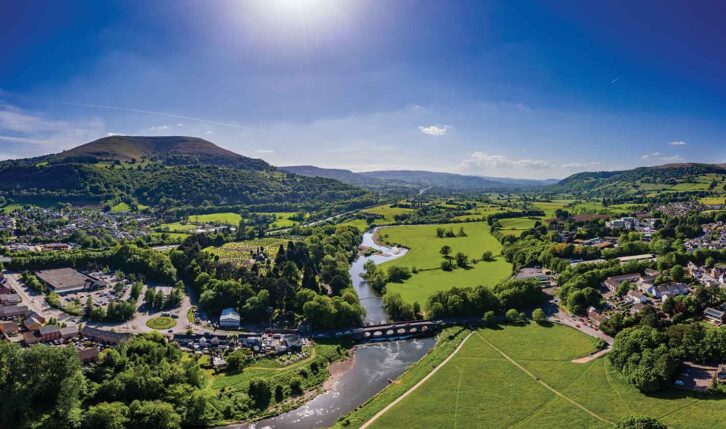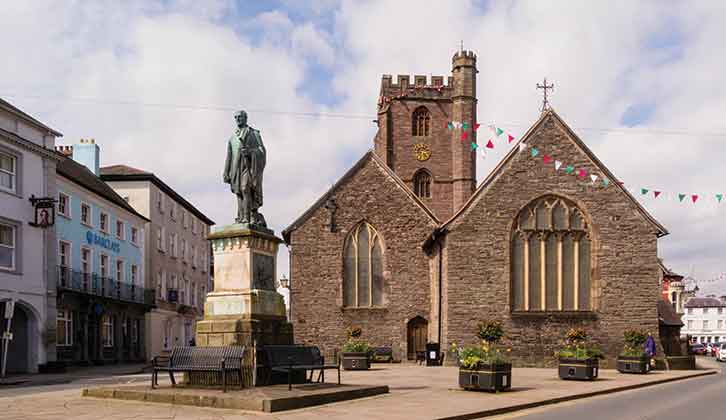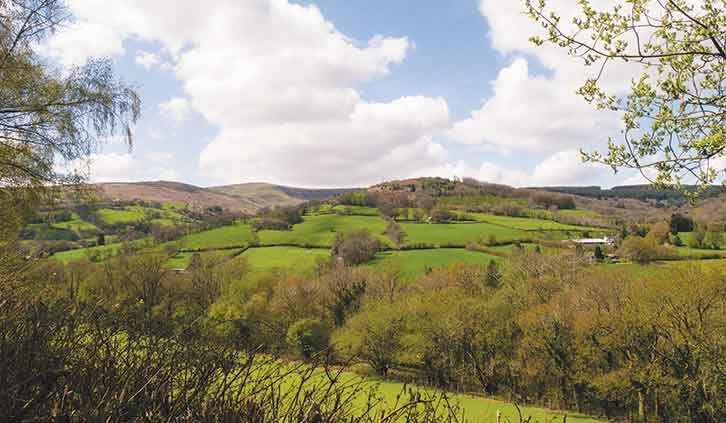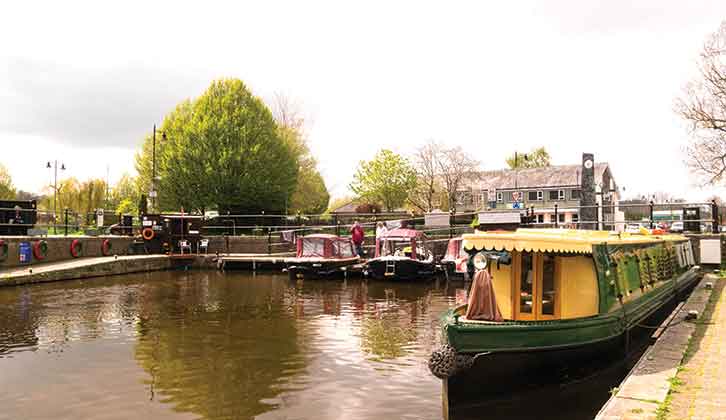After the long pause for winter, it was time to get out on the road again. My housemate, Pearl, and I didn’t want to go too far on this trip, so we opted for the Brecon Beacons (now officially renamed Bannau Brycheiniog National Park), which are a comparatively easy journey from our home in North Wales.
We were searching for motorhome sites in Wales that fulfilled our criteria of being a small place with all of the facilities we require, with easy access to public transport; we prefer to set up our motorhome and avoid driving during our stay, to save a bit of fuel and cash.
We soon came up with an absolute gem of a site, Pencelli Castle Caravan & Camping Park, family run and lying in the quiet area of Powys, with stunning views and easy walks just four miles from Brecon. With no heavy lifting needed to dispose of chemical waste, and really spotless facilities, the site also has a warm drying room and fridge/freezers for guests’ use.
As well as a bus service between Brecon and Abergavenny, Pencelli Castle is just a short walk to access the well-maintained towpaths of the Monmouthshire & Brecon Canal.
I have already voted for the site in Practical Motorhome’s 2024 Top 100 Sites survey, because it’s one of the best motorhome sites we have ever stayed on.
At this truly peaceful place, the only notable sounds during our stay were birdsong, and the bleating of sheep and lambs.
Gateway to Wales
We arrived at the site in the mid-afternoon and because it was a very pleasant day and it was an ideal campsite for a canal walk, we decided to explore the canal towpath.
Even though it was only April, there was some activity, with a couple of narrowboats making their way to Brecon. While we were sitting in quiet contemplation on a bench on the towpath, we suddenly heard excited voices, and a group of schoolchildren in canoes and on paddle boards appeared. They were staying at the Plas Pencelli Outdoor Education Centre and clearly having the time of their lives – we watched them for a while before returning to the site for a quiet evening.
Unfortunately, the next morning was wet, so we decided to catch the bus to Abergavenny, also known as the Gateway to Wales, because it is very close to the border.

The town has plenty of interesting shops and good cafés to explore (and get out of the rain!), and we could also make use of our Welsh bus passes for the journey.
There is a very pleasant café in the Nicholls department store, in Frogmore Street, which we chose for our morning coffee break. It was so warm and cosy there, allowing us to dry off, that we also spent quite a bit of time browsing the clothes and accessories.
The rain showed no sign of easing, though, so in the end, we decided just to brave the weather and head for Abergavenny Castle and Museum.
The castle was established by a Norman baron, Hamelin de Balun, in 1087, and had a turbulent history. It was the site of a massacre of Welsh nobles in 1175. In the 15th century, it was attacked in the Glyndŵr Rising, now known as the last war of Welsh independence. The castle has been Grade I listed since 1952.
The museum is housed in the keep on the high point of the castle motte, in a hunting lodge built for the Marquess of Abergavenny in 1819. It holds a collection of local artifacts, as well as fascinating old photographs of the town, and archaeological items that were discovered when the Post Office and Telephone Exchange was built in the 1960s.
Axe- and arrow-heads dating to prehistoric times are also on display in this eclectic archive, as is a Welsh kitchen from the 1890s, a saddler’s and a grocer’s shop, and valuable items associated with Father Ignatius, a prominent figure in the Catholic Revival of the 19th century, and Lady Llanover, who played an important part in the promotion of Welsh culture.
Gardens and meadows
From there, we headed towards the Linda Vista Gardens, a charming park with attractive formal gardens of unusual specimen shrubs and trees and a wide variety of plants. Open-air concerts are held here during the town’s annual summer festival.
Continuing our explorations, we then strolled around Castle Meadows, more than 20 hectares of riverside land with a lovely path alongside the River Usk. Like Linda Vista Gardens, this would be a particularly fine place to visit on a sunnier day, but even on a dull grey morning, it provided us with a very pleasant walk.
As we came out of the meadows towards the castle, we joined a section of the National Cycle Network No 42, a cycle path from Llanthony to Usk and Brymawr, taking us right up to the walls of the castle.
Going to the market
Having worked up a good appetite, we returned to the café in Nicholls department store for lunch, before taking a leisurely stroll past the impressive Market Hall in Cross Street.
Here, there is a popular general market every Tuesday, Friday and Saturday, a flea market every Wednesday, a craft fair every second Saturday in the month, and a farmer’s market every fourth Thursday in the month. This impressive venue is clearly still playing a very important part in Abergavenny’s daily life.
The Market Hall was built in 1870 to a design by the architectural partnership Wilson & Willcox of Bath. As well as the market, it housed the council chambers and offices, the Assembly Rooms (now the Borough Theatre) and a clock tower. On the first floor, there was a corn exchange, and these days, the building also hosts a popular cinema.

The weather was much improved next day, so we decided to walk a 2.5-mile route along the canal towpath, to explore the pretty village of Talybont-on-Usk. There were more people out and about enjoying the sunshine, and we passed numerous narrowboats travelling on the canal.
We stopped for morning coffee at the Canalside Café in the village, before taking the easy 4km route of the Henry Vaughan Trail. This interesting footpath is named after a famous local scholar, soldier, poet and doctor.
Henry and his twin brother, Thomas, who was a priest and an alchemist, were born in 1621 at the nearby Newton Farm, just across the valley from Talybont. Both of them fought for the royalists in the Civil War, and later published many volumes of poetry, along with a number of devotional, alchemical and medical works.
Henry, whose writings influenced many later poets including William Wordsworth, is buried in the churchyard at Llansantffraed.
Extracts of the brothers’ poetry can be found on signposts along the route of the walk and you can stop at Henry Vaughan’s Garden, where a selection of herbs grows, including many of those he would have used to treat his patients.
This is a lovely spot, with a picnic table and seats, perfect to pause and enjoy the peace and quiet. Towards its end, the path joins a track that forms part of the Taff Trail, the 55-mile cycling and walking path leading through the Bannau Brycheiniog National Park.
Talybont-on-Usk
Returning to Talybont-on-Usk, we went back to the Canalside Café for a delicious lunch, before wandering slowly along the towpath to reach the campsite. On the way, we met another group of children paddling canoes on the canal. They were from a school in Kent, they told us – they were obviously enjoying themselves on the water.

Having worked up a bit of a thirst, we decided to stop for a drink at The Royal Oak in Pencelli. Although we didn’t try the food, this welcoming and popular pub has a varied menu for meals. It is quite small, though, so you might need to book a table for dinner, but there is a large beer garden at the back, alongside the canal.
Exploring historic Brecon
After another restful night, and on the final full day of our trip, we opted for catching the local bus to Brecon, the bustling market town on the edge of the Bannau Brycheiniog National Park, known for its famous jazz festival, independent shops and welcoming cafés.
Brecon is the third largest town in Powys and the start/end of the Monmouthshire & Brecon Canal, which we think has to be one of the prettiest canals in the UK.
This is a very easy town to walk around, too, so we headed to Coffee #1 for our morning coffee, before wandering among the many interesting shops. Time was passing, so we looked for a café for lunch and as we both love waffles and crepes, we opted for A.J’s Crepes, Waffles and Shakes in the High Street. We were not disappointed!
Suitably refreshed, we decided to walk the 4.5 miles back to the campsite, so we headed for Brecon Basin Canal Wharf. There we saw motorboats for hire and many narrowboats moored on the Wharf. This is also the home of Theatr Brycheiniog, Brecon’s Centre for the Arts, which opened in April 1997.

This hugely popular venue provides a varied programme in its 477-seat auditorium, as well as having a 120-seat studio, along with meeting rooms. The Andrew Lamont Gallery shows the work of local, national and international artists. The restaurant/bar serves an excellent selection of locally sourced food and drink.
It is a very scenic walk along the towpath here, with the Usk running beside the canal, and about halfway along, the Brynich Lock, which raises and lowers the water level of the canal, allowing passing narrowboats to navigate the waterway.
We stopped to watch people opening the lock gates so their narrowboat could continue on the rest of the journey to Brecon Wharf.
Canalside walking
A short distance further on is a rather splendid aqueduct, which takes the canal over the River Usk, and as we neared the end of our walk, we could see lines of charmingly decorated narrowboats moored along the canalside.
As we passed the garden of The Royal Oak, the temptation of a refreshing drink was too strong to ignore – we were quite weary after our walk, and thought we deserved a half of Rev James, an excellent ale from local brewery Brains.
So ended our brief visit to this fascinating and stunning area. Both Pearl and I thoroughly enjoyed the trip and felt very rested after our leisurely explorations, ready for our easy drive back home the following morning.
What to know before embarking on a tour to Brecon
When to go to Brecon
Brecon is an excellent touring destination all year round, but it can be cold and snowy in the winter. Like all of Wales, rain can be quite regularly expected, too! The town and its surroundings can also become fairly busy during the peak holiday season.
Way to go
From North Wales, we followed the A483 to Porthmadog, then picked up the A470, which took us almost all of the way to Brecon. The site at Pencelli is on a narrow road, the B4558, which is more easily approached from the Brecon side, with a turn off the A40.
Where we stayed
Pencelli Castle Caravan & Camping Park
Pencelli, Brecon, Powys LD3 7LX
- Tel: 01874 665 451
- Price: £34
The site is an ideal spot for a relaxing break and easy walking alongside the Monmouthshire & Brecon Canal. There is a limited local bus service between Brecon and Abergavenny.
Find out more
If you’ve enjoyed reading this article, why not get the latest news, reviews and features delivered direct to your door or inbox every month. Take advantage of our brilliant Practical Motorhome magazine SUBSCRIBERS’ OFFER and SIGN UP TO OUR NEWSLETTER for regular weekly updates on all things motorhome related.